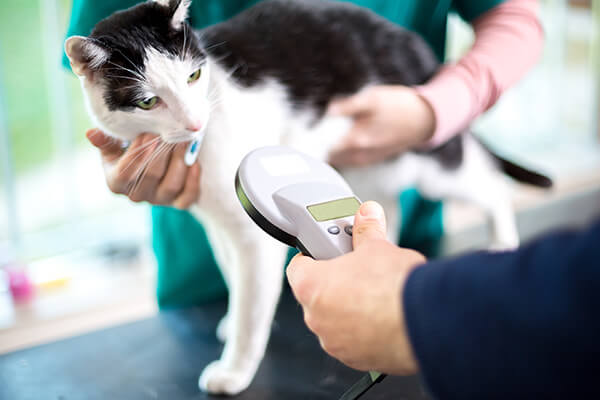
It is estimated that every year, approximately 10 million pets are lost in the United States. Unfortunately, a good majority will end up in an animal shelter. It is a sad reality that less than 20 percent of dogs and less than 3 percent of cats that arrive at a shelter without ID tags or microchips are reunited with their owners. In this article we will look at some of the things you can do to prevent your pet from getting lost and if they are lost, how best to increase your chances of finding them.

Prevention Starts At Home
I.D. Tags and Registration
Make sure your pet wears an external ID tag at all times. If your pet does manage to escape, external ID tags are the most reliable way to get them home quickly.
- Make sure that the current ID tag includes your contact name, address, and phone numbers on their ID tag.
- It’s a good idea even if your pet is an “indoor” pet. In the event that they escape or get out and lost by mistake, an ID will make it much easier to identify them and get them home.
- Registering your pet with a county license is also a good way of having a record in the event that they are lost
Microchipping your pet
A pet microchip is a radio-frequency identification (

*NOTE. It is important that your pet is registered with a national database. Just having the implanted microchip is not effective if there is no information for the unique ID to cross-referenced. Organizations such as Avid, AKCCAR and HomeAgain maintain databases of pets who are microchipped. Before implanting a microchip, your vet will use a microchip scanner to ensure the animal doesn’t already have an existing chip implanted. It is not uncommon for animals that are given or sold to new owners and the information of the microchip is not updated. Important note to owners who received pets from a shelter. Change the registration to your information from that of the shelters once you have them.
Making sure you home is safe and secure
A well-secured home is essential to reducing the chance that your pet could get out unexpectedly and become lost. Make sure that all doors and windows not only shut when closed, but also latch securely. Check screens for tears, or weak points that a pet might be able to break and crawl through. If you need to leave your door propped open for any length of time, keep your pet in a secured room or a pet crate for the duration.
In recent times, electronic home security video cameras and video doorbells like the Ring doorbell are available. These can be helpful if a pet were to escape from a house or yard. If caught on camera the footage could give you some key information like what time the pet had left and also the direction they were traveling.
When your pet is outdoors
If you are going for a walk, it is always a good idea to keep your pet on a leash. In the event that your pet gets startled, tries to chase a squirrel or encounters another animal and flees, they can quickly get away from you, become disoriented and get far away from your original location. If you let you pets go out in a yard or enclosure, make sure that any gates have secure latches and that there aren’t any compromised places within fencing where a pet might get through and escape. Also, look for areas around the fence that might have been dug up. both dogs and cats can burrow a space large enough to squeeze under a fence.

Holidays (Fourth Of July)
Holidays often involve gatherings, family coming over and lots of open doors! While entertaining a lot of guests, it is often difficult to keep track of where your pets, especially if people are coming and going. Keep communication going among household members to check in and know where your pets are at regular intervals.
More dogs and cats go missing on The Fourth of July than any other day! It’s understandable that the terribly loud and constant noises can cause fear and confusion. Make sure your pets stay inside when there are a lot of fireworks going on and make doubly sure that any accessible doors and windows are secured. For more tips and helpful methods of keeping your pets calm during the fireworks on Independence Day, take a look at our blog post dedicated to 4th of July Pet Safety Tips
Where To Start If Your Pet Is Lost
- Take action immediately. Time is valuable in increasing the chances of finding your pet quickly.
- Double check all areas of your home, yard etc.
- Go to Social media. Put up a post with a picture, the pets name and time and location last seen. Share to neighborhood groups as well and ask others to share.
- Search your neighborhood or location. Bring treats and a familiar toy if possible. Be careful to stop and listen frequently in between calling your pets name as they may be hiding and afraid to come out. Listen for noises in bushes, cries or whimpering.
- Contact local animal shelters, veterinarian offices and animal control facilities
- Print up flyers with picture(s), helpful info and last known location and time seen

